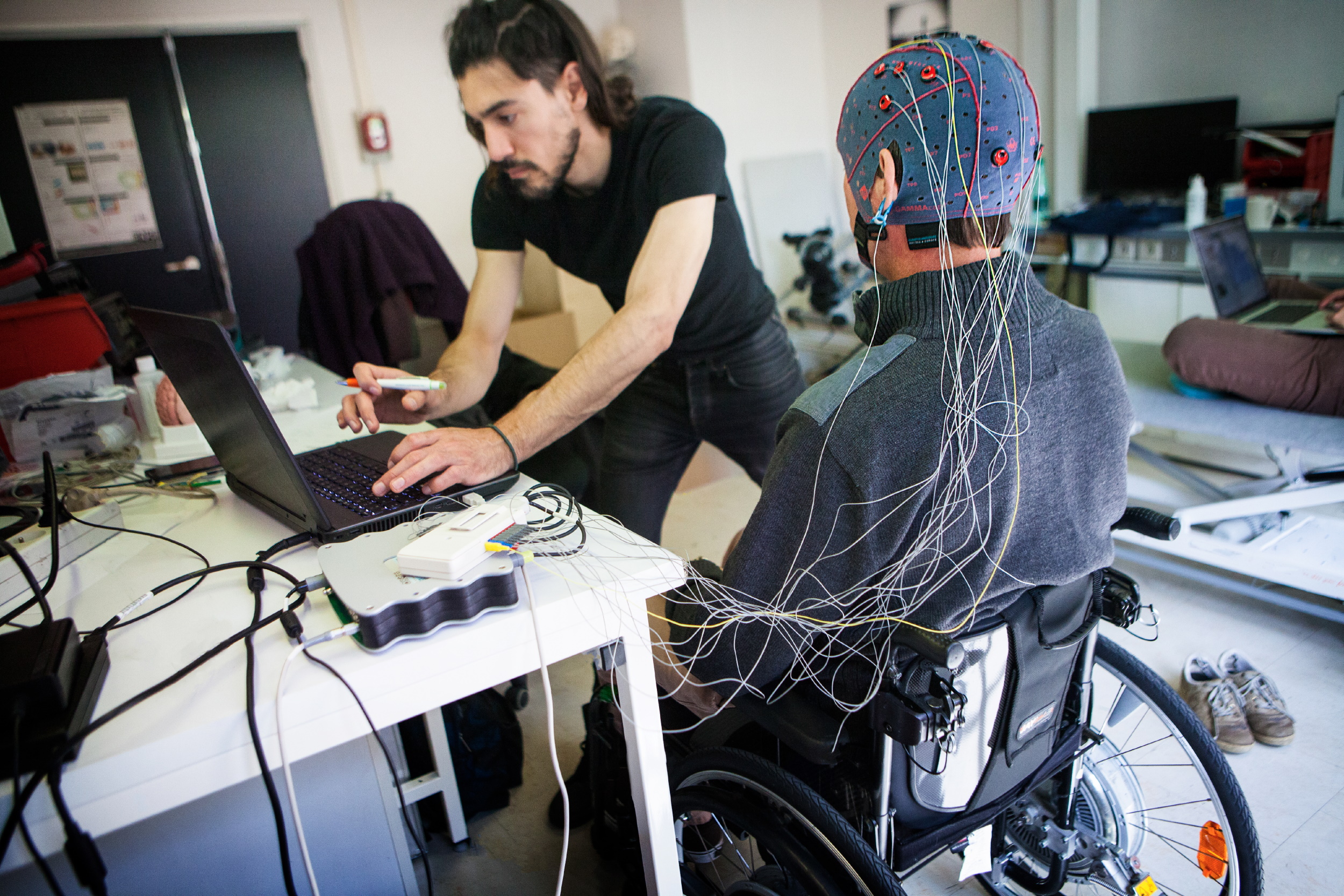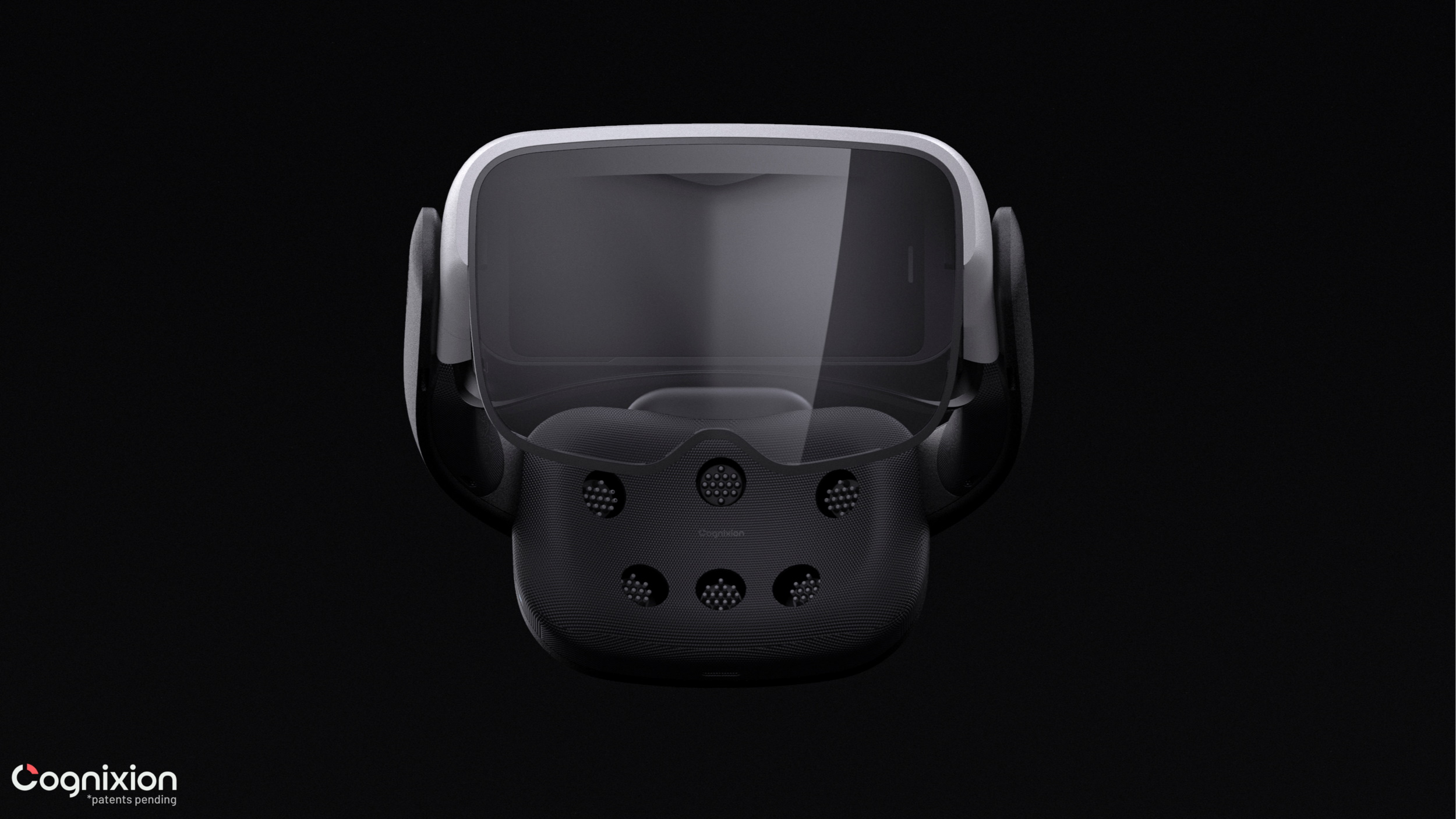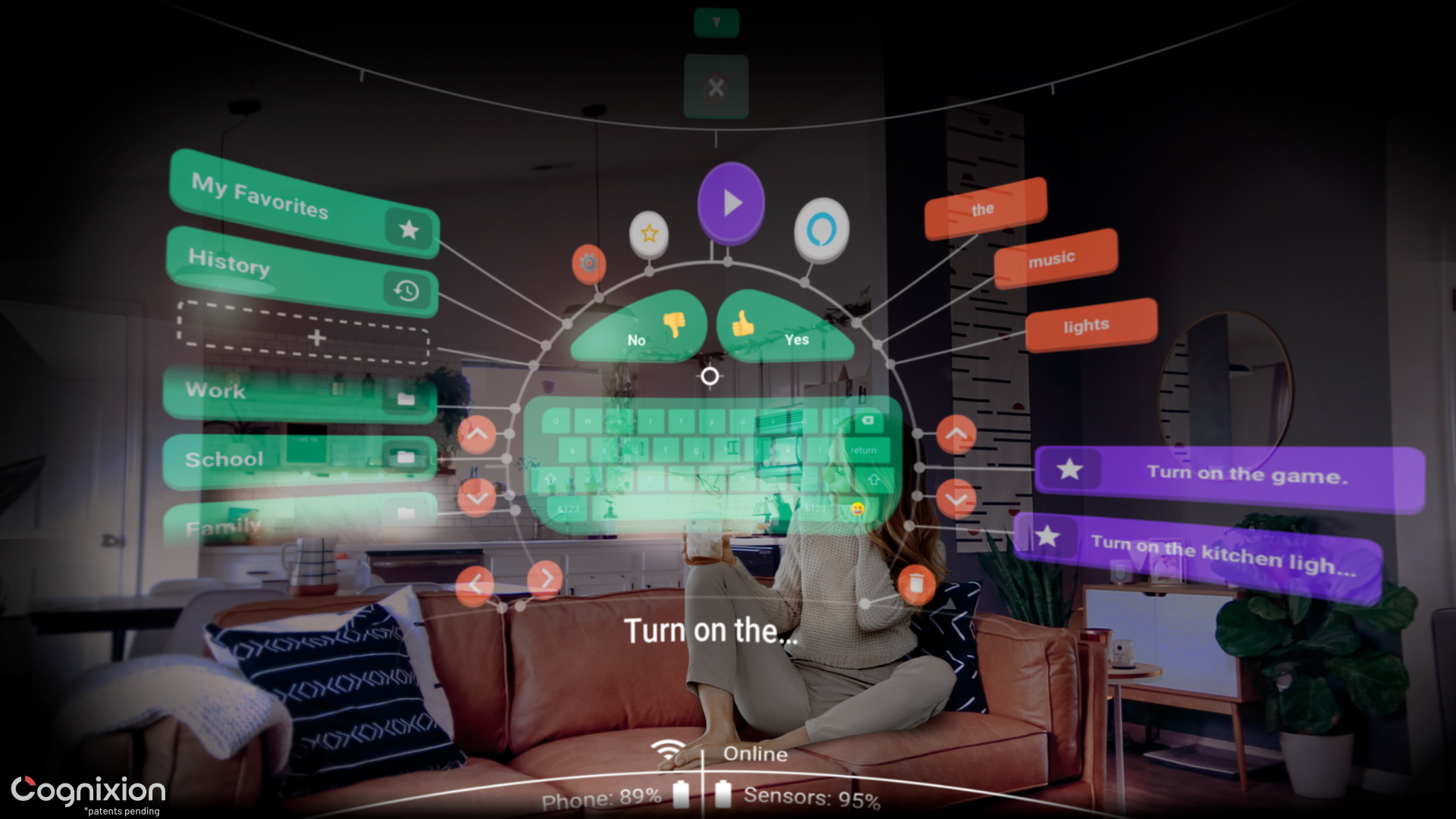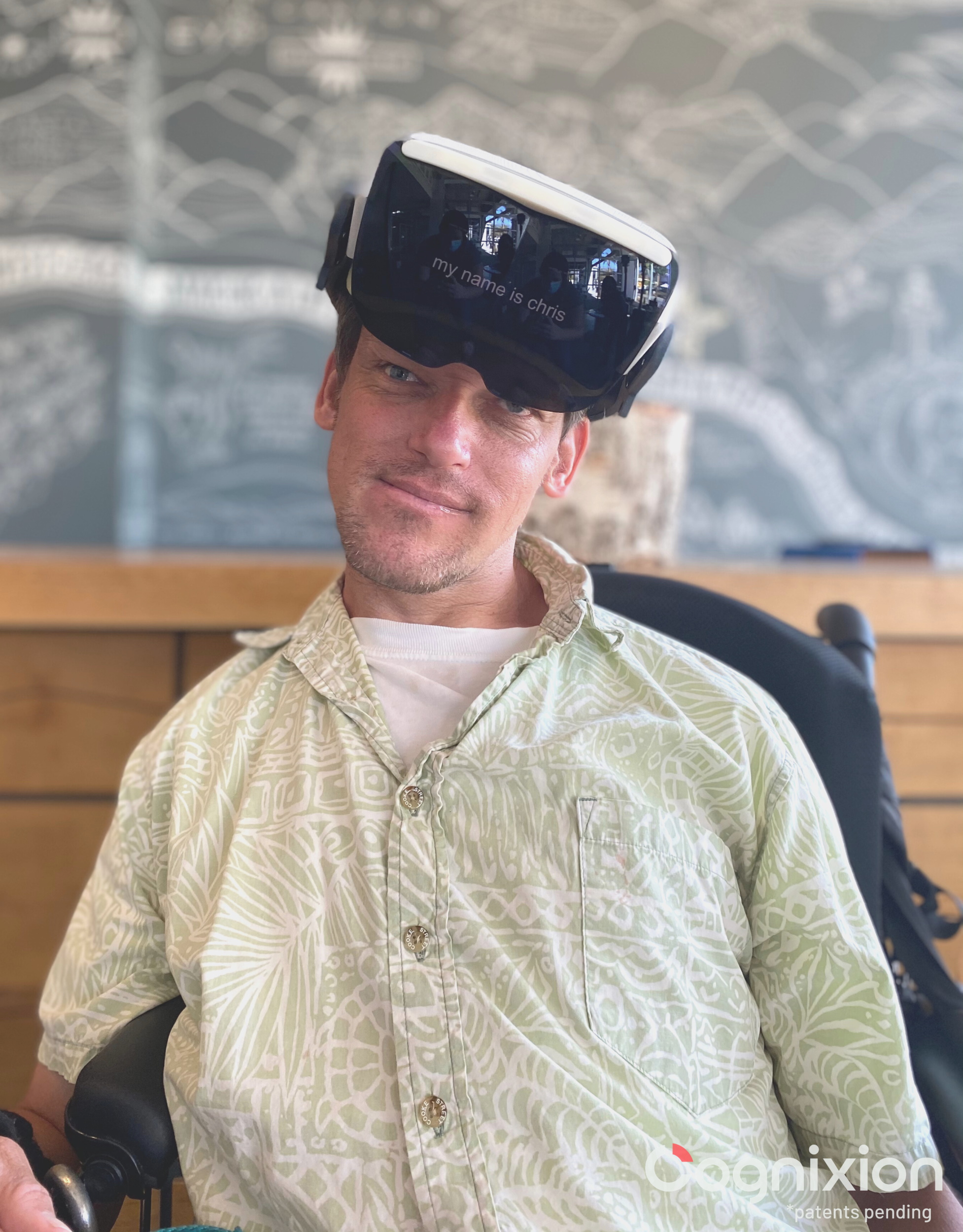News: Cognixion’s brain-monitoring headset enables fluid communication for people with severe disabilities
Of the many frustrations of having a severe motor impairment, the difficulty of communicating must surely be among the worst. The tech world has not offered much succor to those affected by things like locked-in syndrome, ALS, and severe strokes, but startup Cognixion aims to with a novel form of brain monitoring that, combined with
Of the many frustrations of having a severe motor impairment, the difficulty of communicating must surely be among the worst. The tech world has not offered much succor to those affected by things like locked-in syndrome, ALS, and severe strokes, but startup Cognixion aims to with a novel form of brain monitoring that, combined with a modern interface, could make speaking and interaction far simpler and faster.
The company’s One headset tracks brain activity closely in such a way that the wearer can direct a cursor — reflected on a visor like a heads-up display — in multiple directions or select from various menus and options. No physical movement is needed, and with the help of modern voice interfaces like Alexa, the user can not only communicate efficiently but freely access all kinds of information and content most people take for granted.
But it’s not a miracle machine, and it isn’t a silver bullet. Here’s where how it got started.
Overhauling decades-old brain tech
Everyone with a motor impairment has different needs and capabilities, and there are a variety of assistive technologies that cater to many of these needs. But many of these techs and interfaces are years or decades old — medical equipment that hasn’t been updated for an era of smartphones and high-speed mobile connections.
Some of the most dated interfaces, unfortunately, are those used by people with the most serious limitations: those whose movements are limited to their heads, faces, eyes — or even a single eyelid, like Jean-Dominique Bauby, the famous author of “The Diving Bell and the Butterfly.”
One of the tools in the toolbox is the electroencephalogram, or EEG, which involves detecting activity in the brain via patches on the scalp that record electrical signals. But while they’re useful in medicine and research in many ways, EEGs are noisy and imprecise — more for finding which areas of the brain are active than, say, which sub-region of the sensory cortex or the like. And of course you have to wear a shower cap wired with electrodes (often greasy with conductive gel) — it’s not the kind of thing anyone wants to do for more than an hour, let alone all day every day.
Yet even among those with the most profound physical disabilities, cognition is often unimpaired — as indeed EEG studies have helped demonstrate. It made Andreas Forsland, co-founder and CEO of Cognixion, curious about further possibilities for the venerable technology: “Could a brain-computer interface using EEG be a viable communication system?”
He first used EEG for assistive purposes in a research study some five years ago. They were looking into alternative methods of letting a person control an on-screen cursor, among them an accelerometer for detecting head movements, and tried integrating EEG readings as another signal. But it was far from a breakthrough.

A modern lab with an EEG cap wired to a receiver and laptop – this is an example of how EEG is commonly used.
He ran down the difficulties: “With a read-only system, the way EEG is used today is no good; other headsets have slow sample rates and they’re not accurate enough for a real-time interface. The best BCIs are in a lab, connected to wet electrodes — it’s messy, it’s really a non-starter. So how do we replicate that with dry, passive electrodes? We’re trying to solve some very hard engineering problems here.”
The limitations, Forsland and his colleagues found, were not so much with the EEG itself as with the way it was carried out. This type of brain monitoring is meant for diagnosis and study, not real-time feedback. It would be like taking a tractor to a drag race. Not only do EEGs often work with a slow, thorough check of multiple regions of the brain that may last several seconds, but the signal it produces is analyzed by dated statistical methods. So Cognixion started by questioning both practices.
Improving the speed of the scan is more complicated than overclocking the sensors or something. Activity in the brain must be inferred by collecting a certain amount of data. But that data is collected passively, so Forsland tried bringing an active element into it: a rhythmic electric stimulation that is in a way reflected by the brain region, but changed slightly depending on its state — almost like echolocation.
They detect these signals with a custom set of six EEG channels in the visual cortex area (up and around the back of your head), and use a machine learning model to interpret the incoming data. Running a convolutional neural network locally on an iPhone — something that wasn’t really possible a couple years ago — the system can not only tease out a signal in short order but make accurate predictions, making for faster and smoother interactions.
The result is sub-second latency with 95-100 percent accuracy in a wireless headset powered by a mobile phone. “The speed, accuracy and reliability are getting to commercial levels — we can match the best in class of the current paradigm of EEGs,” said Forsland.
Dr. William Goldie, a clinical neurologist who has used and studied EEGs and other brain monitoring techniques for decades (and who has been voluntarily helping Cognixion develop and test the headset), offered a positive evaluation of the technology.
“There’s absolutely evidence that brainwave activity responds to thinking patterns in predictable ways,” he noted. This type of stimulation and response was studied years ago. “It was fascinating, but back then it was sort of in the mystery magic world. Now it’s resurfacing with these special techniques and the computerization we have these days. To me it’s an area that’s opening up in a manner that I think clinically could be dramatically effective.”
BCI, meet UI
The first thing Forsland told me was “We’re a UI company.” And indeed even such a step forward in neural interfaces as he later described means little if it can’t be applied to the problem at hand: helping people with severe motor impairment to express themselves quickly and easily.
Sad to say, it’s not hard to imagine improving on the “competition,” things like puff-and-blow tubes and switches that let users laboriously move a cursor right, right a little more, up, up a little more, then click: a letter! Gaze detection is of course a big improvement over this, but it’s not always an option (eyes don’t always work as well as one would like) and the best eye-tracking solutions (like a Tobii Dynavox tablet) aren’t portable.
Why shouldn’t these interfaces be as modern and fluid as any other? The team set about making a UI with this and the capabilities of their next-generation EEG in mind.
Their solution takes bits from the old paradigm and combines them with modern virtual assistants and a radial design that prioritizes quick responses and common needs. It all runs in an app on an iPhone, the display of which is reflected in a visor, acting as a HUD and outward-facing display.
In easy reach of, not to say a single thought but at least a moment’s concentration or a tilt of the head, are everyday questions and responses — yes, no, thank you, etc. Then there are slots to put prepared speech into — names, menu orders, and so on. And then there’s a keyboard with word- and sentence-level prediction that allows common words to be popped in without spelling them out.
“We’ve tested the system with people who rely on switches, who might take 30 minutes to make 2 selections. We put the headset on a person with cerebral palsy, and she typed our her name and hit play in 2 minutes,” Forsland said. “It was ridiculous, everyone was crying.”
Goldie noted that there’s something of a learning curve. “When I put it on, I found that it would recognize patterns and follow through on them, but it also sort of taught patterns to me. You’re training the system, and it’s training you — it’s a feedback loop.”
“I can be the loudest person in the room”
One person who has found it extremely useful is Chris Benedict, a DJ, public speaker, and disability advocate who himself has Dyskinetic Cerebral Palsy. It limits his movements and ability to speak, but doesn’t stop him from spinning (digital) records at various engagements, however, or from explaining his experience with Cognixion’s One headset over email. (And you can see him demonstrating it in person in the video above.)
“Even though it’s not a tool that I’d need all the time it’s definitely helpful in aiding my communication,” he told me. “Especially when I need to respond quickly or am somewhere that is noisy, which happens often when you are a DJ. If I wear it with a Bluetooth speaker I can be the loudest person in the room.” (He always has a speaker on hand, since “you never know when you might need some music.”)
The benefits offered by the headset give some idea of what is lacking from existing assistive technology (and what many people take for granted).
“I can use it to communicate, but at the same time I can make eye contact with the person I’m talking to, because of the visor. I don’t have to stare at a screen between me and someone else. This really helps me connect with people,” Benedict explained.
“Because it’s a headset I don’t have to worry about getting in and out of places, there is no extra bulk added to my chair that I have to worry about getting damaged in a doorway. The headset is balanced too, so it doesn’t make my head lean back or forward or weigh my neck down,” he continued. “When I set it up to use the first time it had me calibrate, and it measured my personal range of motion so the keyboard and choices fit on the screen specifically for me. It can also be recalibrated at any time, which is important because not every day is my range of motion the same.”
Alexa, which has been extremely helpful to people with a variety of disabilities due to its low cost and wide range of compatible devices, is also part of the Cognixion interface, something Benedict appreciates, having himself adopted the system for smart home and other purposes. “With other systems this isn’t something you can do, or if it is an option, it’s really complicated,” he said.
Next steps
As Benedict demonstrates, there are people for whom a device like Cognixion’s makes a lot of sense, and the hope is it will be embraced as part of the necessarily diverse ecosystem of assistive technology.
Forsland said that the company is working closely with the community, from users to clinical advisors like Goldie and other specialists, like speech therapists, to make the One headset as good as it can be. But the hurdle, as with so many devices in this class, is how to actually put it on people’s heads — financially and logistically speaking.
Cognixion is applying for FDA clearance to get the cost of the headset — which, being powered by a phone, is not as high as it would be with an integrated screen and processor — covered by insurance. But in the meantime the company is working with clinical and corporate labs that are doing neurological and psychological research. Places where you might find an ordinary, cumbersome EEG setup, in other words.
The company has raised funding and is looking for more (hardware development and medical pursuits don’t come cheap), and has also collected a number of grants.
The One headset may still be some years away from wider use (the FDA is never in a hurry), but that allows the company time to refine the device and include new advances. Unlike many other assistive devices, for example a switch or joystick, this one is largely software-limited, meaning better algorithms and UI work will significantly improve it. While many wait for companies like Neuralink to create a brain-computer interface for the modern era, Cognixion has already done so for a group of people who have much more to gain from it.
You can learn more about the Cognixion One headset and sign up to receive the latest at its site here.






